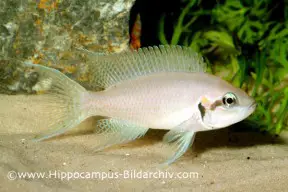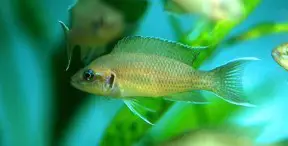Neolamprologus pulcher
Brichardi
SynonymsTop ↑
Lamprologus savoryi elongatus Trewavas & Poll, 1952; Lamprologus elongatus (Trewavas & Poll, 1952); Lamprologus brichardi Poll, 1974; Neolamprologus brichardi (Poll, 1974)
Classification
Order: Perciformes Family: Cichlidae
Distribution
Endemic to and widely-distributed throughout Lake Tanganyika with type locality the town of Kasanga in southwestern Tanzania.
Habitat
Areas of shoreline with rocky substrates.
Maximum Standard Length
70 – 90 mm.
Aquarium SizeTop ↑
Single fish or pairs can be kept in quite small aquaria but if you want to see it display natural cooperative breeding behaviour (see ‘Reproduction’) use something with base dimensions upwards of 120 ∗ 30 cm or equivalent.
Maintenance
Should be housed in a Lake Tanganyika biotope set-up, with piles of rocks arranged to form caves filling much of the aquarium. A sandy substrate is preferable.
Water Conditions
Temperature: 23 – 27 °C
pH: 8 – 9
Hardness: 161 – 447 ppm
Diet
Live and frozen foods should comprise a large proportion of the diet. Dried foods can be fed, but less often. Some vegetable matter, such as spirulina or blanched spinach should also be fed.
Behaviour and CompatibilityTop ↑
Not an ideal resident of the community aquarium since it’s aggressively territorial, especially when protecting fry, and is therefore best kept in a species tank under most circumstances.
In large set-ups it can be maintained successfully with other small to medium-sized Tanganyikan cichlids that occupy different areas of the tank such as Cyprichromis or shell-dwelling species.
Other rockdwellers such as Julidochromis or Altolamprologus are only possibilities if the tank is large enough and sufficient territories and broken lines-of-sight are provided.
Sexual Dimorphism
Adult males are usually slightly larger and develop longer extensions to the dorsal and caudal fins than females.
Reproduction
This species is a substrate-spawner depositing its eggs on the roof of rocky caves in nature, and is easily-bred in aquaria.
Unless a bonded adult pair is available its best to begin with a group of at least six young individuals, removing the additional fish once a pair forms.
The fish will swim together as a group and pair off to spawn, retaining the pair bond for future spawns. A pair will spawn secretly in a cave which they often excavate themselves, with the female laying up to 200 eggs (but usually far less) on the wall or roof of it. Once spawning has occured, the female will tend to the eggs while the male guards the area around the cave. The eggs will hatch in 2-3 days, with the fry becoming free swimming at around the 7 day stage.
The fry are large enough to take brine shrimp nauplii from birth but are quite slow growing. Brood care is quite long-lived, with the entire group helping the parents in guarding the fry.
Once the parents stop protecting the brood, they are allowed to remain in the group and will actively help to guard the next generation of fry. This continues as the fish breed, and it is possible to have several generations living peacefully together, with the older fish guarding the younger. However, if a point is reached where the space becomes saturated, the breeding fish will begin to lay fewer eggs or even eat the smallest fish in the tank. So, if you wish to raise good numbers of young on a regular basis it is better to remove the fry to a separate rearing tank. Removing the fry also prevents defomities resulting from inbreeding.
NotesTop ↑
Known by a number of vernacular names including Fairy Cichlid, Lyretail Cichlid and Princess of Burundi
Deservedly one of the most popular Tanganyikan species available in the hobby, N. brichardi is ideal for newcomers to both Rift Lake cichlids and cichlids in general, being beautiful and easy to keep and breed. It is seen for sale under several common names including “Fairy Cichlid”, “Lyretail Cichlid” and “Princess of Burundi”. There are several colour morphs available, although these do not vary much in patterning, and an albino form is also occasionally available. The different species in the so-called “Brichardi complex”, which include N. crassus, falcicula, gracilis, helianthus, pulcher, savoryi and splendens, should not be mixed in aquaria as they will hybridise freely.
In nature, N. brichardi can be found in shoals of many thousands, exhibiting the same altruistic nature towards spawning pairs and young fish as is seen in aquaria but on a truly massive scale.




October 21st, 2012 at 11:59 am
I keep this fish for 40 years. The fishes now in my tank are the descendant of the six fishes I bought in 1970.
Diet
Feeding with dry food in flakes only is possible, even for reproduction. Even young fishes come up with the flakes for the adults.
Water
This fish even spawn in water with pH 7.0
Behaviour
Elder children stay a long time with their parents, often helping them to care the younger siblings. 1″-1.5″ long brichardis very often defeat the territorial against Siamese Algae Eater in my tank. Even the Common Bristlenose Catfishes are often attackted. Maybe the brichardis are better get a tank for their own.